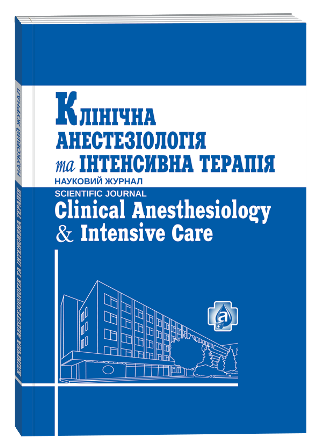MODERN APPROACHES TO THE DIAGNOSIS AND COMPREHENSIVE CORRECTIION OF THROMBOSIS IN PATIENTS WITH ELEVATED BODY MASS INDEX ON UTERINE FIBROIDS DURING LAPAROSCOPIC MYOMECTOMMY
DOI:
https://doi.org/10.31379/2411.2616.16.2.7Keywords:
uterine fibroids, body mass index, laparoscopy, thrombosis, thromboprophylaxisAbstract
One of the main methods of surgical treatment of uterine fibroids in women of reproductive age is laparoscopic myomectomy. The many advantages of this method of surgical treatment lead, in many cases, to an underestimation of the existing risk, such as thrombosis in women with elevated body mass index. The aim of this study is to identify the state of thrombosis and to choice adequate complex thromboprophylaxis in patients with elevated body mass index in the perioperative period under laparoscopic myomectomy, using an instrumental diagnosis method of, that is low-frequency piezoelectric hemoviscometer. Materials and methods. Patients 30-45 years with BMI> 30 who undergo laparoscopic myomectomy (n = 44). The patient were divided into two groups: Group 1 (n = 18) – patients with BMI> 30 kg / m2, who for thromboprophylaxis used Enoxyparin 2000 anti-Xa IU / 0.2 ml subcutaneously (with BMI 30-40 kg / m2) and 4000 anti-Xa IU / 0.4 ml subcutaneously (with BMI> 40); Group 2 (n = 26) included patients with BMI> 30 kg / m2, who for thromboprophylaxis used Enoxyparin 2000 anti-Xa IU / 0.2 ml subcutaneously (with BMI 30-40 kg / m2), 4000 anti-Xa IU / 0.4 ml subcutaneously (with BMI> 40) and Pentoxifylline 200 mg intravenously. The control group (n = 16) included patients with BMI <30 kg / m2, to whom the medicamentous thromboprophylaxis was not performed. All patients underwent endotracheal anesthesia using Sevoflurane The state of the hemostasis system before the surgery, as well as on the 1st and 3rd day after the surgery was monitored by standard biochemical tests, as well as an instrumental method to estimate the functional state of the components of the hemostasis system and fibrinolysis – LOW FREQUENCY VIBRATION PIEZOELECTRIC (LFVP). Results. After evaluation of standard biochemical tests to estimate hemostasis before the surgery, on the 1st and 5th day after the surgery in all groups of patients obvious and significant pathological changes were not detected. According to LFVP, there were statistically significant (p <0.05) deviations from the reference values of the hemostasiogram moving up in structural (increase in MA -maximum clot density) and chronometric (acceleration of the time of formation of fibrin-platelet structure T5, displacement of the gelling point T3 to the left, increase in ICD indicator) hypercoagulation, increase of thrombin activity (rise of TAC, reduced T2 time), activation of vascular and platelet hemostasis (reduced period of beginning of T2 reaction, increased ICC indicator), suppression of lytic activity (reduced CLRI) of the blood in 1 and 2 groups of patients. On the first day after the surgery in groups 1 and 2 there is a significant increase (compared to preoperative indicators) of such chronometric indicators as T1, T2, T5; reduction of the structural indicator of MA, as well as a significant decrease in TAC, ICD on the first day after surgery, which confirms the effectiveness of antithrombotic therapy. However, in group 1 there is increased activity of vascularplatelet hemostasis, higher ICC compared with group 2, shorter T1 time, T2 and higher TAC. On the 5th day after surgery, a normocoagulation trend of hemostatic potential was observed in all groups of patients. Conclusions. 1. The use of low-frequency piezoelectric hemiscosimetry allows to evaluate accurately and quickly the thrombosis kinetics. 2. Risk of thrombosis at the perioperative stage of laparoscopic myomectomy are revealed in patients with uterine fibroids who have a BMI> 30. 3. In patients of group 1 who received for the purpose of thromboprophylaxis only Enoxyparin correction of changes in the hemostasis system is less effective and is characterized by higher vascular platelet activity, moderate positive changes in coagulation potential and fibrinolytic activity compared with patients in group 2 4. Complex correction of hemostasis disorders in patients of group 2 is effective significantly and affects both vascular platelet link and coagulation link of hemostasis.
References
Макаров 0.В., Озолиня Л.А., Керчелаева С.Б. Профилактика тромбоэмболических осложнений в гинекологии. Российский вестник акушера-гинеколога. 2005. № 4. С.52-56.
Стеценко А.И. Использование анализатора реологических свойств крови АРП – 01 ,,Меднорд,, в клинической практике. Актуальные проблемы клинических исследований агрегатного состояния крови (2-й выпуск): материалы научно-практической конференции.
Хоробрых О.С. Проблемы оказания анестезиологических пособий у пациенток с ожирением в акушерстве. ЗДРАВООХРАНЕНИЕ ЮГРЫ: опыт и инновации. 2018. №4.
Ендоскопічна хірургія: навчальний посібник / Запорожан В.М. та ін. Всеукраїнське спеціалізоване видавництво «Медицина», 2019.
Особенности профилактики интраоперационных тромбоэмболических осложнений у пациентов с морбидным ожирением/ Буриков М.А. та ін. Клиническая практика. 2018 Т.9. №3. С.44-47.
Обоснование выбора метода профилактики тромбоэмболических осложнений при лапароскопических операциях на органах брюшной полости и малого таза / Кательницкий Иг.И. та ін. Современные проблемы науки и образования. 2016. №6.
Duranteau, J., et al. European guidelines on perioperative venous thromboembolism prophylaxis: Intensive care. Eur J Anaesthesiol. 2018. Vol. 35 (2). P. 142–146.







